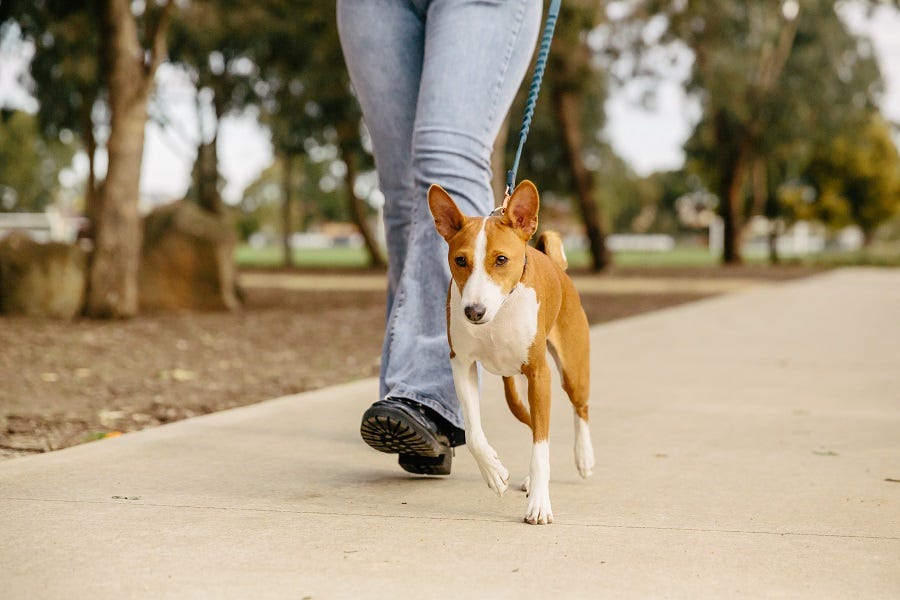Got questions about dog walking? We're here to talk the talk to help you walk the W-A-L-K with your four-legged family. How often you should walk your dog and for how long depends on a few factors: age, breed, living situation and health. Read on to learn more about your dog’s needs.
Dog walking based on age
Walking puppies
Puppies sure seem like they've always got energy to spare, and while walking your pup is a crucial part of their health and training, they do have limits! It's important not to over- or under-exercise a puppy, so finding that sweet spot is key.
A rule of thumb for puppies is a 5-minute walk per month of age. So a 4-month-old pup (with all its vaccinations!) can manage about 20-minutes of walking a day. Use this rule as a guide, but pay closer attention to your puppy's behaviour. If they're acting sluggish, try shortening your walks. Or if they're hyperactive at home, try lengthening their walks or adding in extra play and training.
Learn how to train a puppy to walk on a lead in this helpful article.
Walking adult dogs
Once your pooch has graduated from puppyhood, the next rule of thumb is roughly two 30-minute walks a day for high-energy dogs and a 15- to 30-minute walk for lower-energy dogs. This can include a mix of on- and off-leash walking or running. You'll know your dog's energy levels better than anyone, so adjust their amount of exercise based on their energy levels and behaviour. Please factor in their breed, too – more on that below.
A healthy, active dog of the right breed will enjoy long walks and even difficult terrain, so if you're a hiker or adventurer, high-energy dogs will be a good match for you. If you have a limited amount of time, don't have a big backyard and don't enjoy exercise yourself, consider a smaller dog that may require less walking.
Walking older dogs
As your dog gets older, they might not keep up like they used to! Keep an eye on their energy levels and recovery time after walks, and scale back the length of your walks as needed. Try to stick to flat, easy terrain and avoid any big jumps. If your older dog has health conditions like joint problems or obesity, your vet can help you make a plan to keep them active within their limits.
Dog walking based on breed
Walking high-energy dog breeds
If your pooch is a working dog, like sheepdogs and kelpies, or a hunting dog, like a dalmatian, they may require more extended periods of exercise each day.
Walking lower-energy dog breeds
Lapdogs and smaller breeds, like chihuahuas or shih tzus, may need less walking overall, or at least shorter walks broken up throughout the day.
Brachycephalic breeds
Dogs with shortened snouts like pugs struggle to cool themselves through the membranes in their nose, so they are easily overexerted. Speak with your vet to ensure you're giving your brachycephalic dog enough exercise.
Consult your vet about your dog's needs
Each dog is individual, so they may need less or more exercise than the general rule for their breed. Ask your vet what you should know about your dog's breed's needs and make adjustments as you get to know your dog.
Factors such as their fur and coat can impact how efficiently your dog can cool themselves down and maintain energy over a walk. Speak with the Our Vet team or the Best Friends Pets grooming team to learn how to best care for your dog's natural coat.
Dog walking based on health
Your dog's limits for exercise will change throughout their life. If your dog's health or ability changes, your vet can help you create an exercise program that keeps them active enough within their capability. You may need to alter your walking routine and speak with a vet if you notice any of the following:
● Your dog seems stiff
● Your dog is walking slower than usual
● Your dog is panting heavier or more quickly than expected on walks – they may need extra hydration or shorter walks
● Your dog has an injury
● Your dog develops any conditions or diseases
Dog walking based on living situation
Your dog's size compared to the size of your living space, will impact how much incidental exercise they can get. A small dog in a big backyard can often get enough running around that you only need take it for a short walk each day or do some active training and playing. A big dog in a small space will need extra walks to stretch their legs and burn off some energy to help keep them healthy and avoid them getting restless or hyperactive.
How do I know if I'm walking my dog enough?
You might be under-walking your dog if they're over-energetic or destructive around the house. You might be over-walking your dog if they're slow, stiff or tired.
What can I do if I can't take my dog walking enough?
Beyond walking your pooch, you can use forms of enrichment for dogs to help keep their brains stimulated and encourage physical activity. Dog enrichment can involve teaching your dog tricks and introducing toys like puzzles or a KONG stuffed with treats. Dog puzzle toys can help challenge your fur baby's brain, and while it's not a substitute for walks and physical activity, it can get them moving and keep their mental cogs turning!
Whether you're training, playing, walking or hiking with your dog, treats are a great way to encourage a healthy lifestyle. Check out SavourLife Reward treats to discover recipes for dental health, coat health, and general well-being with non-artificial flavours and Australian ingredients – 50% of profits go toward helping rescue dogs. If you're not walking your dog often because you're strapped for time, try enlisting the help of friends, family or a dog walker, or splitting the walk into shorter halves in the morning and evening.
Keeping your dog safe on walks on hot days
Keeping the whole family hydrated – especially on summer adventures – is important; a travel dog bowl for your pooch (and bottles of water for you) can keep you all enjoying activities for longer! Keeping your dog appropriately groomed can help support their natural cooling mechanisms too – this can involve shaving single coated breeds, trimming double coated breeds, and keeping your dog’s paw pad hair trimmed back to help heat escape from their feet.
On days over 25℃, it’s probably safer to skip the walk to avoid risk of heatstroke or dehydration – try going early in the morning before it heats up. Keep an eye on your pooch for signs of excessive panting or drooling when you are out in the sun. Check out our other articles to learn more about keeping your dog cool, summer grooming and how to take care of your dog in the Australian sun.
How can I keep my dog comfortable on walks?
A comfortable dog walking harness and lead can help encourage your dog to keep trotting along. You can learn more about how to fit a puppy harness properly in this article, or watch our video about correctly fitting a dog harness. The Rogz Airtech range has plenty of reliable harnesses, leads and collars to help you find the right fit. Also, don’t forget your dog walking bags so your pooch can listen to nature’s call!
Our loyal companions are usually happy to take our lead, so finding a walking route you enjoy can help create more of those pawsome family memories. We hope your walks help keep the whole family feeling happy and healthy!




